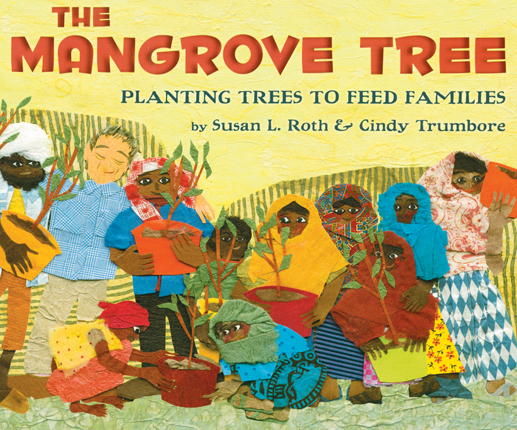| Mangrove tree : planting trees to feed families Author: Roth, Susan L. | ||
| Price: $23.96 | ||
Summary:
The transformation in Eritrea when Dr. Gordon Sato, a Japanese American cell biologist, plants mangrove trees.
| Added Entry - Personal Name: | Trumbore, Cindy |
| Accelerated Reader Information: Interest Level: LG Reading Level: 6.40 Points: .5 Quiz: 144631 | Reading Counts Information: Interest Level: K-2 Reading Level: 10.80 Points: 1.0 Quiz: 54367 | |
Common Core Standards
Grade K → Reading → RI Informational Text → K.RI Key Ideas & Details
Grade K → Reading → RI Informational Text → K.RI Craft & Structure
Grade K → Reading → RI Informational Text → K.RI Integration of Knowledge & Ideas
Grade K → Reading → RI Informational Text → K.RI Range of Reading & Level of Text Complexity
Grade K → Reading → RI Informational Text → Texts Illustrating the Complexity, Quality, & Rang
Grade 1 → Reading → RL Reading Literature → 1.RL Craft & Structure
Grade 1 → Reading → RI Informational Text → 1.RI Key Ideas & Details
Grade 1 → Reading → RI Informational Text → 1.RI Craft & Structure
Grade 1 → Reading → RI Informational Text → 1.RI Integration of Knowledge & Ideas
Grade 1 → Reading → RI Informational Text → Texts Illustrating the Complexity, Quality, & Rang
Grade 1 → Reading → CCR - College & Career Readiness Anchor Standards
Grade 1 → Reading → RI Informational Text → 1.RI Range of Reading & Level of Text Complexity
Grade 2 → Reading → RI Informational Text → 2.RI Key Ideas & Details
Grade 2 → Reading → RI Informational Text → 2.RI Craft & Structure
Grade 2 → Reading → RI Informational Text → 2.RI Integration of Knowledge & Ideas
Grade 2 → Reading → RI Informational Text → 2.RI Range of Reading & Level of Text Complexity
Grade 2 → Reading → RI Informational Text → Texts Illustrating the Complexity, Quality, & Rang
Grade 2 → Reading → CCR College & Career Readiness Anchor Standards fo
Grade 4 → Reading → RI Informational Text → 4.RI Key Ideas & Details
Grade 4 → Reading → RI Informational Text → 4.RI Craft & Structure
Grade 4 → Reading → RI Informational Text → 4.RI Integration of Knowledge & Ideas
Grade 4 → Reading → RI Informational Text → Texts Illustrating the Complexity, Quality, & Rang
Grade 4 → Reading → CCR College & Career Readiness Anchor Standards fo
Grade 5 → Reading → RI Informational Text → 5.RI Key Ideas & Details
Grade 5 → Reading → RI Informational Text → 5.RI Craft & Structure
Grade 5 → Reading → RI Informational Text → 5.RI Integration of Knowledge & Ideas
Grade 5 → Reading → RI Informational Text → Texts Illustrating the Complexity, Quality, & Rang
Grade 5 → Reading → CCR College & Career Readiness Anchor Standards fo
Reviews:
Kirkus Reviews (03/15/11)
School Library Journal (05/01/11)
Booklist (05/15/11)
Full Text Reviews:
School Library Journal - 05/01/2011 Gr 3–6—This is a true story set in a small village in Eritrea. "The families used to be hungry./Their animals were hungry too./But then things began to change.../all because of a tree." In poignant text that alternates between cumulative verse and prose, Roth and Trumbore describe how Dr. Gordon Sato, a Japanese-American cell biologist, helped to relieve poverty and famine by planting mangrove trees in salt water. Tended mainly by women, the trees flourished and multiplied, supplying food for animals and fish that, in turn, provided food for the people. Roth's large paper and fabric textured collages first reveal a barren village that is then gradually transformed as pots of mangrove seedlings are transplanted and become abundant mangrove forests. Depictions of women in colorfully patterned long dresses and head scarves, shepherds in capes and head coverings, and children playing outside houses "made of cloth, tin cans, and flattened iron" convey a sense of place and culture. The cumulative poem ends with an introduction to and picture of the smiling scientist himself: "This is Gordon,/Whose greatest wish/Is to help.../By planting trees,/Mangrove trees,/By the sea." A lengthy afterword contains additional information about Dr. Sato and photos of him working with the local people. Pair this inspiring story with Donna Napoli's Mama Miti: Wangari Maathai and the Trees of Kenya (S & S, 2010) to spark discussion about how one individual can improve the lives of others.—Marianne Saccardi, formerly at Norwalk Community College, CT - Copyright 2011 Publishers Weekly, Library Journal and/or School Library Journal used with permission.
Booklist - 05/15/2011 Japanese American scientist Dr. Gordon Soto started a project to plant mangrove seedlings in a village in the drought-stricken African country of Eritrea, near the Red Sea, and he helped a village move from poverty and hunger to a self-sufficient community. With a picture-book format and a simple cumulative verse, this title about Dr. Soto’s project seems like a story for young children, but both the elaborate collage art and the prose text feel aimed at an upper-elementary audience. The biology, explained in detail on each right-hand page and in a long afterword with photographs, describes how mangrove trees thrive in salty water and how Soto added more chemicals to the mix to help the ecosystem thrive. Young children may enjoy the chanting, rhyming lines (“These are the seedlings / that grew into trees”), but older readers will likely skip over the poetry to get to the amazing true story, including Soto’s imprisonment in the Manzanar internment camp during WWII. The final spreads include photographs and sources. A great choice for cross-curricular sharing. - Copyright 2011 Booklist.



